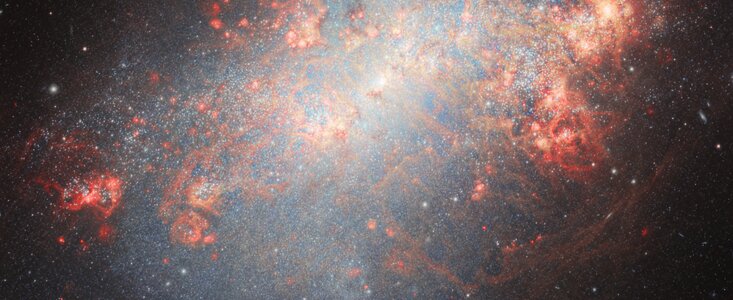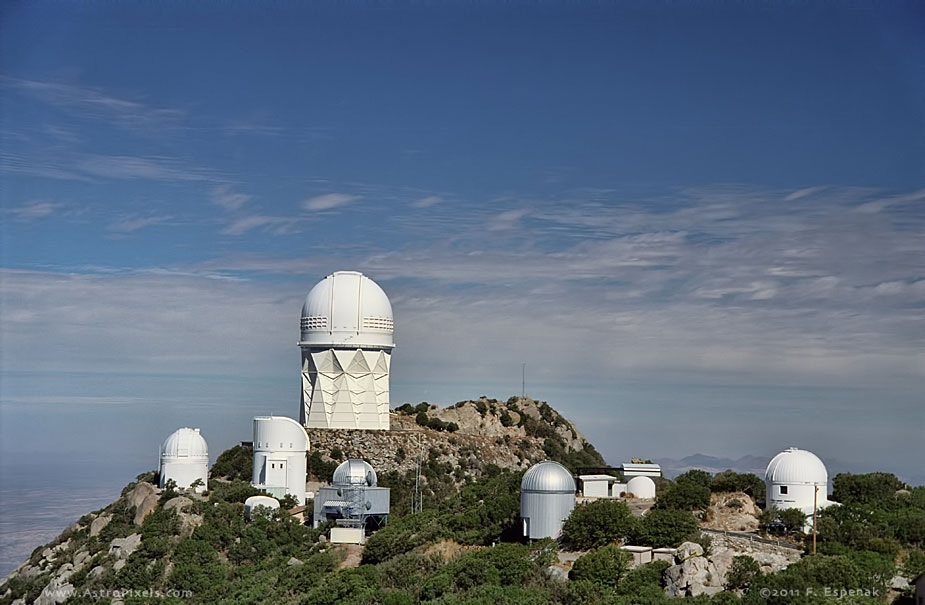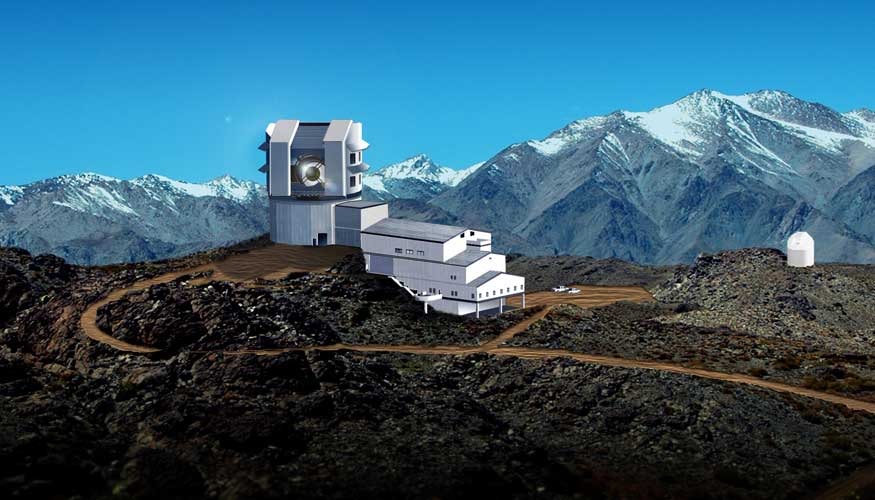From The NSF NOIRLab NOAO Gemini Observatory
6.25.24
Josie Fenske
NSF NOIRLab
Email: josie.fenske@noirlab.edu
Irregular galaxy NGC 4449 exhibits explosive rate of star formation activity due in part to ongoing mergers with nearby dwarf galaxies.

A festive array of bright pinks and blues makes for a remarkable sight in this image captured with the Gemini North telescope [below], one half of the International Gemini Observatory. Resembling a cloud of cosmic confetti, this image is being released in celebration of Gemini North’s 25th anniversary. NGC 4449 is a prime example of starburst activity caused by the interacting and mingling of galaxies as it slowly absorbs its smaller galactic neighbors.

An explosive array of bright pinks and blues makes for a remarkable sight in this image captured with the Gemini North telescope, one half of the International Gemini Observatory. Resembling a cloud of cosmic confetti, this image is being released in celebration of Gemini North’s 25th anniversary. NGC 4449 is a prime example of starburst activity caused by the interacting and mingling of galaxies as it slowly absorbs its smaller galactic neighbors. Credit: International Gemini Observatory/NOIRLab/NSF/AURA. Image Processing: J. Miller (International Gemini Observatory/NSF NOIRLab), M. Rodriguez (International Gemini Observatory/NSF NOIRLab), T.A. Rector (University of Alaska Anchorage/NSF NOIRLab), M. Zamani (NSF NOIRLab)
Much of the visible matter in the Universe, the matter that makes up stars, planets — and us — is made inside stars as they complete their cycle of birth, life, and death. They are born from clouds of gas and dust, and when they die their remains are recycled back into the interstellar medium to be used as fuel for the next generation of stars. And in a not-so-distant corner of the Universe, 13 million light-years away in the constellation Canes Venatici, the beginning of this cycle is unfolding at an exceptional rate.
NGC 4449, also known as Caldwell 21, appears to be putting on a cosmic fireworks show in this image, captured with the Gemini North telescope, one half of the International Gemini Observatory, which is supported in part by the U.S. National Science Foundation and operated by NSF NOIRLab. The galaxy’s billowing red clouds and sparkling blue veil are lighting up the sky with the colors of newly forming stars. It’s classified as an irregular Magellanic-type galaxy, reflecting its loose spiral structure and close resemblance to the Large Magellanic Cloud — the prototype of Magellanic galaxies.



Stars have been actively forming within NGC 4449 for several billion years, but currently it is pumping out new stars at a much higher rate than in the past. This unusually explosive and intense star formation activity qualifies it as a starburst galaxy. While starbursts usually occur in the central regions of galaxies, NGC 4449’s star formation is more widespread, evidenced by the fact that the youngest stars are both in the nucleus and in streams surrounding the galaxy.
This ‘global’ starburst activity resembles the Universe’s earliest star-forming galaxies, which grew by merging with and accreting smaller stellar systems. And like its galactic predecessors, NGC 4449’s rapid star formation was likely ignited by interactions with neighboring galaxies. As a member of the Messier 94 Group of galaxies — one of the closest galaxy groups to the “Local Group”, which hosts the Milky Way — NGC 4449 lies in close proximity to a handful of surrounding smaller galaxies.

Astronomers have found evidence of interactions between NGC 4449 and at least two of these satellite galaxies.
One is a very dim dwarf galaxy that is actively being absorbed, as evidenced by a diffuse stream of stars extending to one side of NGC 4449. This ‘stealth’ merger is nearly undetectable by visual inspection owing to its diffuse nature and low stellar mass. However, it possesses a large amount of dark matter, meaning its presence can be detected by the substantial gravitational influence it has on NGC 4449. The other object that provides hints of a past merger is a massive globular star cluster embedded within the outer halo of NGC 4449. This cluster is thought by astronomers to be the surviving nucleus of a former gas-rich satellite galaxy now in the process of being absorbed by NGC 4449.
As NGC 4449 interacts with and absorbs its smaller galactic companions, the tidal interactions between the galaxies compress and shock the gas. The glowing red regions scattered across this image showcase this process, indicating an abundance of ionized hydrogen — a telltale sign of ongoing star formation. A plethora of hot, young blue star clusters are emerging from the galactic ovens, fueled by the dark filaments of cosmic dust lacing throughout the galaxy. At the current rate, the gas supply that feeds NGC 4449’s production of stars will only last for another billion years or so.
This image is being released today in celebration of the Gemini North telescope’s 25th anniversary. On 25 June 1999 a dedication ceremony was held on Maunakea, Hawai‘i, to unveil the new world-class 8.1-meter telescope and reveal its first-light images, which at the time were some of the sharpest infrared images ever obtained by a ground-based telescope. Over the past two and a half decades Gemini North’s large mirror, powerful suite of instruments and advanced adaptive optics have allowed astronomers to peer further and further into the cosmos. From capturing the first direct image of a multi-planet system to testing Albert Einstein’s General Theory of Relativity — which helped astronomers earn the 2020 Nobel Prize — Gemini North has contributed greatly to humanity’s understanding of the Universe.
See the full article here .
Comments are invited and will be appreciated, especially if the reader finds any errors which I can correct.

five-ways-keep-your-child-safe-school-shootings
Please help promote STEM in your local schools.













Gemini’s mission is to advance our knowledge of the Universe by providing the international Gemini Community with forefront access to the entire sky.
The NSF NOIRLab Gemini Observatory is an international collaboration with two identical 8-meter telescopes. The Frederick C. Gillett Gemini Telescope is located on Maunakea, Hawai’i (Gemini North) and the other telescope on Cerro Pachón in central Chile (Gemini South); together the twin telescopes provide full coverage over both hemispheres of the sky. The telescopes incorporate technologies that allow large, relatively thin mirrors, under active control, to collect and focus both visible and infrared radiation from space.
The Gemini Observatory provides the astronomical communities in six partner countries with state-of-the-art astronomical facilities that allocate observing time in proportion to each country’s contribution. In addition to financial support, each country also contributes significant scientific and technical resources. The national research agencies that form the Gemini partnership include: the US National Science Foundation (NSF), the Canadian National Research Council (NRC), the Chilean Comisión Nacional de Investigación Cientifica y Tecnológica (CONICYT), the Australian Research Council (ARC), the Argentinean Ministerio de Ciencia, Tecnología e Innovación Productiva, and the Brazilian Ministério da Ciência, Tecnologia e Inovação. The observatory is managed by the Association of Universities for Research in Astronomy, Inc. (AURA) under a cooperative agreement with the NSF. The NSF also serves as the executive agency for the international partnership.
National Science Foundation’s NOIRLab (National Optical-Infrared Astronomy Research Laboratory ), the US center for ground-based optical-infrared astronomy, operates the international Gemini Observatory (a facility of NSF, National Research Council Canada (CA), Agancia Nacional de IInvestigacion y Desarrollo (CL), Ministry of Science, Technology and Innovation [Ministério da Ciência, Tecnologia e Inovações] (BR), Ministry of Science, Technology and Innovation | Argentina.gob.Ministerio de Ciencia, Tecnología e Innovación | Argentina.gob.(AR), and Korea Astronomy and Space Science Institute[알림사항](KR), Kitt Peak National Observatory (KPNO) , NSF NOAO Cerro Tololo Inter-American Observatory (CL), the NOAO Community Science and Data Center (CSDC), and Vera C. Rubin Observatory in cooperation with DOE’s SLAC National Accelerator Laboratory .).



It is managed by the Association of Universities for Research in Astronomy (AURA) under a cooperative agreement with National Science Foundation and is headquartered in Tucson, Arizona.
The Dark Energy Survey
Dark Energy Camera [DECam] built at the DOE’s Fermi National Accelerator Laboratory.

The astronomical community is honored to have the opportunity to conduct astronomical research on Iolkam Du’ag (Kitt Peak) in Arizona, on Maunakea in Hawaiʻi, and on Cerro Tololo and Cerro Pachón in Chile. We recognize and acknowledge the very significant cultural role and reverence that these sites have to the Tohono O’odham Nation, to the Native Hawai’ian community, and to the local communities in Chile, respectively.




